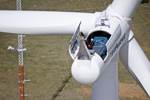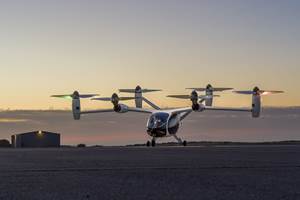Wind energy is top source for new electric capacity in the U.S.
2015 ranks as the third highest year for wind installations on record.
Wind energy installed more electric generating capacity in 2015 than any other energy source in the U.S., according to data from the American Wind Energy Association (AWEA, Washington, D.C.) and the recently released Business Council for Sustainable Energy (BCSE) and Bloomberg New Energy and Finance (BNEF) 2016 Factbook.
The 8.6 gigawatts (GW) of wind power capacity installed last year surpassed the 7.3 GW of new solar photovoltaic capacity during 2015 and the 6 GW installed by natural gas. Wind accounted for more than 35 percent of new generating capacity, while all renewable resources together provided 68 percent of the new capacity, according to the Factbook.
“Wind’s growth is being propelled by cost reductions of two-thirds over the last six years, which now makes wind the lowestcost source of new generation,” said Tom Kiernan, CEO of the American Wind Energy Association (AWEA), at the annual winter meeting of the National Association of Regulatory Utility Commissioners (NARUC), in the Renaissance Hotel, Washington, D.C.
“It’s one of the biggest, fastest, cheapest ways we can reduce U.S. carbon emissions, and the low-cost solution for power sector reductions. Utilities and other purchasers are turning to wind energy also because it provides stably-priced energy with no fuel price risk, and protects consumers by creating a more diverse energy portfolio,” Kiernan said.
After a strong finish last year, wind energy is off to a good start in 2016, with an additional 9.4 GW under construction, an additional 4.9 GW in advanced stages of development, and a predictable federal Production Tax Credit for the next several years.
“With long-term policy certainty in place, wind power is ready to keep this American success story going,” said Mike Garland, CEO of Pattern Energy and current AWEA Board Chair. “Further investments in our technology will enable utilities to cut costs and pass on the savings to American homeowners and businesses.”
With wind energy costs at an all-time low and the recent extension of key federal tax incentives for wind and solar, new analysis using a Department of Energy modeling tool concludes, “The tax extenders allow states to meet pending carbon dioxide regulations almost exclusively with zero-emitting renewables.”
Zero-emission wind energy also provides states and utilities with more flexible options for reducing pollution, relative to energy sources with some emissions which would require the replacement of far more existing generation to achieve the same level of emissions cuts.
The rapid growth of renewables and the continued retirement of coal plants have not significantly impacted retail prices, according to BCSE and BNEF’s 2016 Factbook. The report states “retail electricity rates across the country remain 5.8 percent below the recent peak (2008).”
Innovations by the wind industry have helped lower wind power’s costs by two-thirds in the last six years, as shown by the Lawrence Berkeley National Laboratory. The Wall Street investment firm Lazard also found a cost decline of more than 60 percent, and notes that wind energy is the lowest cost energy source for reducing emissions, even before tax incentives.
With today’s installed U.S. capacity, wind energy produces enough electricity for more than 19 million American homes. Iowa, South Dakota and Kansas all source more than 20 percent of their annual electricity from wind. Wind power already provides a total of nine states with 12 percent or more of their annual electricity
The Department of Energy’s Wind Vision report shows a path for wind power to double in the next five years and supply 20 percent of U.S. electricity needs by 2030. 2015 ranks as the third highest year for wind installations on record. American wind power has installed as much as 13,124 MW in a single year, 2012, when wind also was the largest source of new electrical generating capacity as it was last year.
Related Content
Composites end markets: Batteries and fuel cells (2024)
As the number of battery and fuel cell electric vehicles (EVs) grows, so do the opportunities for composites in battery enclosures and components for fuel cells.
Read MoreNovel composite technology replaces welded joints in tubular structures
The Tree Composites TC-joint replaces traditional welding in jacket foundations for offshore wind turbine generator applications, advancing the world’s quest for fast, sustainable energy deployment.
Read MoreHow composites have become a necessity
Composites used to be one of many material options across industries and applications, but that's not the case anymore.
Read MoreJEC World 2023 highlights: Recyclable resins, renewable energy solutions, award-winning automotive
CW technical editor Hannah Mason recaps some of the technology on display at JEC World, including natural, bio-based or recyclable materials solutions, innovative automotive and renewable energy components and more.
Read MoreRead Next
Wind energy gains expected after tax credit extension
Could usher in a new wave of turbine installations in the U.S.
Read More“Structured air” TPS safeguards composite structures
Powered by an 85% air/15% pure polyimide aerogel, Blueshift’s novel material system protects structures during transient thermal events from -200°C to beyond 2400°C for rockets, battery boxes and more.
Read MorePlant tour: Daher Shap’in TechCenter and composites production plant, Saint-Aignan-de-Grandlieu, France
Co-located R&D and production advance OOA thermosets, thermoplastics, welding, recycling and digital technologies for faster processing and certification of lighter, more sustainable composites.
Read More
























